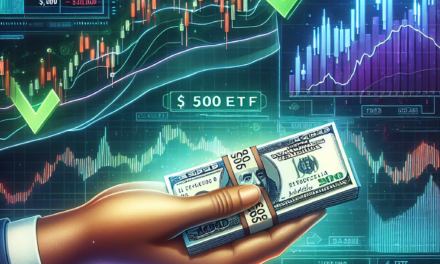“Golden Horizons: Bullion Set to Break Records with 10% Surge!”
Introduction
The gold industry is poised for a significant upswing, with projections indicating a 10% surge in bullion prices over the next year, potentially reaching record highs. This anticipated growth is driven by a confluence of factors, including heightened geopolitical tensions, fluctuating global economic conditions, and increasing demand for safe-haven assets. As investors seek stability amidst market volatility, gold’s allure as a reliable store of value is expected to intensify, further propelling its price upward. This forecasted rise in bullion underscores the dynamic nature of the precious metals market and its responsiveness to global economic shifts.
Factors Driving the 10% Surge in Gold Prices
The gold industry is currently witnessing a remarkable surge, with bullion prices projected to rise by 10% within the next year, potentially reaching unprecedented record highs. This anticipated increase is driven by a confluence of factors that are reshaping the global economic landscape. As investors seek safe havens amid economic uncertainties, gold’s allure as a stable asset is becoming increasingly pronounced. The interplay of geopolitical tensions, inflationary pressures, and shifts in monetary policy are all contributing to this upward trajectory in gold prices.
To begin with, geopolitical tensions have historically played a significant role in influencing gold prices. In recent times, escalating conflicts and diplomatic strains in various regions have heightened global uncertainty. Investors, wary of potential market volatility, often turn to gold as a hedge against geopolitical risks. This renewed interest in gold as a safe-haven asset is driving demand and, consequently, pushing prices upward. Moreover, the ongoing trade disputes and economic sanctions between major economies are further exacerbating these tensions, adding to the appeal of gold as a protective investment.
In addition to geopolitical factors, inflationary pressures are exerting a considerable influence on gold prices. As central banks around the world grapple with rising inflation rates, the purchasing power of fiat currencies is being eroded. In such an environment, gold is perceived as a reliable store of value, prompting investors to increase their holdings. The recent surge in consumer prices, driven by supply chain disruptions and increased demand, has intensified concerns about long-term inflation. Consequently, investors are seeking refuge in gold, which historically retains its value even in times of economic instability.
Furthermore, shifts in monetary policy are playing a pivotal role in shaping the gold market. Central banks, in response to economic challenges, have adopted accommodative monetary policies, including low interest rates and quantitative easing measures. While these policies are intended to stimulate economic growth, they also contribute to currency devaluation. As a result, investors are increasingly turning to gold as a hedge against potential currency depreciation. The prospect of prolonged low interest rates further enhances gold’s attractiveness, as the opportunity cost of holding non-yielding assets diminishes.
Additionally, the growing interest in sustainable and ethical investing is influencing the gold market. Investors are becoming more conscious of the environmental and social impact of their investments, leading to a surge in demand for responsibly sourced gold. This trend is encouraging mining companies to adopt sustainable practices, which, in turn, is affecting supply dynamics. As the industry adapts to these changing preferences, the cost of production may rise, contributing to higher gold prices.
In conclusion, the anticipated 10% surge in gold prices over the next year is underpinned by a complex interplay of factors. Geopolitical tensions, inflationary pressures, and shifts in monetary policy are all driving increased demand for gold as a safe-haven asset. Additionally, the growing emphasis on sustainable investing is reshaping supply dynamics within the industry. As these factors continue to evolve, the gold market is poised for significant growth, with bullion prices potentially reaching record highs. Investors, keen to navigate the uncertainties of the global economy, are likely to maintain their focus on gold as a reliable and enduring asset.
Historical Trends: Gold’s Path to Record Highs
The gold industry has long been a focal point of global economic discussions, with its value often seen as a barometer for broader financial stability. Historically, gold has been a safe haven for investors during times of economic uncertainty, and its price movements are closely watched by market analysts and investors alike. In recent years, the gold market has experienced significant fluctuations, driven by a myriad of factors ranging from geopolitical tensions to shifts in monetary policy. As we delve into the historical trends that have shaped gold’s path to record highs, it becomes evident that the current projection of a 10% surge in bullion prices over the next year is rooted in a complex interplay of historical precedents and contemporary economic dynamics.
To understand the current trajectory of gold prices, it is essential to examine the historical context. Over the past few decades, gold has experienced several notable price surges, often coinciding with periods of economic instability. For instance, during the financial crisis of 2008, gold prices soared as investors sought refuge from volatile stock markets and uncertain economic conditions. Similarly, in the early 1980s, gold reached unprecedented heights in response to high inflation and geopolitical tensions. These historical instances underscore the metal’s enduring appeal as a hedge against economic turmoil.
Transitioning to the present, the gold industry is once again poised for a significant upswing. Analysts predict a 10% increase in bullion prices over the next year, driven by a confluence of factors that echo past trends while introducing new dynamics. One of the primary drivers of this anticipated surge is the current global economic climate, characterized by persistent inflationary pressures and geopolitical uncertainties. As central banks around the world grapple with rising inflation, many investors are turning to gold as a means of preserving wealth, thereby driving up demand and, consequently, prices.
Moreover, the ongoing geopolitical tensions, particularly in regions with significant economic influence, have further fueled the demand for gold. Historically, such tensions have led to increased volatility in financial markets, prompting investors to seek the relative safety of gold. This pattern is evident today as well, with geopolitical developments contributing to the bullish outlook for gold prices.
In addition to these traditional factors, contemporary developments in technology and market access have also played a role in shaping the gold market. The rise of digital trading platforms and increased accessibility to gold investments have broadened the investor base, allowing more individuals to participate in the market. This democratization of gold investment has introduced new dynamics, potentially amplifying price movements as more investors respond to market signals.
As we look to the future, the projected 10% increase in gold prices over the next year is not merely a reflection of current economic conditions but also a continuation of historical trends that have long defined the gold market. While the specific drivers may evolve, the fundamental appeal of gold as a store of value remains unchanged. As such, the gold industry is likely to continue its trajectory toward record highs, buoyed by both enduring and emerging factors. In conclusion, the historical trends that have shaped gold’s path to record highs provide valuable insights into the current and future dynamics of the market, underscoring the metal’s enduring significance in the global economic landscape.
Investment Strategies Amidst Rising Gold Prices
As the gold industry anticipates a significant surge in bullion prices, investors are keenly observing the market dynamics that could propel gold to record highs. The forecasted 10% increase in gold prices over the next year is not merely a speculative assertion but is grounded in a confluence of economic factors that are shaping investment strategies worldwide. Understanding these factors is crucial for investors looking to capitalize on the potential upswing in gold prices.
One of the primary drivers of the anticipated rise in gold prices is the prevailing economic uncertainty. In times of economic instability, gold is traditionally viewed as a safe-haven asset. With global markets experiencing volatility due to geopolitical tensions, fluctuating interest rates, and concerns over inflation, investors are increasingly turning to gold as a means of preserving wealth. This shift in investor sentiment is expected to bolster demand for gold, thereby driving up its price.
Moreover, central banks around the world have been augmenting their gold reserves, further supporting the bullish outlook for gold. This trend is particularly evident in emerging markets, where central banks are diversifying their reserves away from traditional currencies. The strategic accumulation of gold by these institutions not only underscores its enduring value but also contributes to the upward pressure on prices. As central banks continue to prioritize gold in their reserve portfolios, the market is likely to witness sustained demand, reinforcing the positive price trajectory.
In addition to these macroeconomic factors, the supply side of the gold market also plays a pivotal role in shaping price movements. Gold production has faced challenges in recent years, with mining companies grappling with rising operational costs and regulatory hurdles. These constraints on supply, coupled with the steady demand, create a favorable environment for price increases. Investors who are attuned to these supply dynamics can better position themselves to benefit from the anticipated price surge.
Transitioning from the broader market forces to individual investment strategies, it is essential for investors to consider how best to navigate the rising gold prices. Diversification remains a cornerstone of effective investment strategy, and incorporating gold into a diversified portfolio can provide a hedge against market volatility. Investors may choose to invest in physical gold, such as bullion or coins, or explore financial instruments like gold exchange-traded funds (ETFs) and mining stocks. Each option carries its own set of risks and rewards, and careful consideration of these factors is imperative.
Furthermore, timing is a critical element in maximizing returns from gold investments. While the forecasted price increase presents an attractive opportunity, investors must remain vigilant and responsive to market changes. Monitoring economic indicators, geopolitical developments, and central bank policies can provide valuable insights into the optimal timing for entering or exiting gold positions. By staying informed and agile, investors can enhance their ability to capitalize on the upward trend in gold prices.
In conclusion, the gold industry’s projection of a 10% surge in bullion prices over the next year is underpinned by a complex interplay of economic factors and market dynamics. As investors seek to navigate this landscape, understanding the drivers of gold prices and adopting strategic investment approaches will be key to achieving favorable outcomes. By leveraging the insights gained from analyzing both macroeconomic trends and individual investment options, investors can position themselves to benefit from the anticipated rise in gold prices, thereby enhancing their overall investment strategy amidst a backdrop of rising gold prices.
Economic Implications of Surging Gold Values

The gold industry is currently witnessing a remarkable surge, with projections indicating that bullion prices could rise by 10% within a year, reaching unprecedented record highs. This anticipated increase in gold values carries significant economic implications, influencing various sectors and stakeholders globally. As investors and analysts closely monitor these developments, understanding the underlying factors driving this surge and its broader economic impact becomes crucial.
To begin with, the primary catalyst for the rising gold prices is the prevailing economic uncertainty. In times of financial instability, investors traditionally turn to gold as a safe-haven asset. The ongoing geopolitical tensions, coupled with fluctuating global markets, have heightened this sense of uncertainty, prompting a shift towards gold investments. Moreover, inflationary pressures are mounting in several major economies, further enhancing gold’s appeal as a hedge against currency devaluation. As central banks continue to grapple with inflation control measures, the demand for gold is expected to remain robust.
In addition to these macroeconomic factors, the supply dynamics of gold also play a pivotal role in shaping its market value. Gold mining operations have faced numerous challenges, including environmental regulations, rising production costs, and geopolitical constraints. These factors have contributed to a relatively constrained supply, which, when juxtaposed with increasing demand, exerts upward pressure on prices. Furthermore, technological advancements in mining and extraction processes have not kept pace with the growing demand, thereby limiting the potential for a significant increase in supply.
The implications of surging gold values extend beyond the immediate financial markets. For central banks, which hold substantial gold reserves, the increase in gold prices can bolster their balance sheets, providing a buffer against economic volatility. This, in turn, can influence monetary policy decisions, as central banks may adjust their strategies based on the enhanced value of their gold holdings. Additionally, countries with significant gold mining industries stand to benefit economically from higher prices, as increased revenues can support national budgets and stimulate economic growth.
On the other hand, the rising cost of gold can pose challenges for industries reliant on this precious metal. The jewelry sector, for instance, may experience increased production costs, potentially leading to higher prices for consumers. Similarly, the electronics industry, which utilizes gold in various components, could face cost pressures that might be passed on to end-users. These potential price increases could have a ripple effect on consumer spending patterns, influencing broader economic activity.
Moreover, the investment landscape is likely to be impacted by the surging gold values. As gold becomes more attractive, investors may reallocate their portfolios, potentially reducing their exposure to other asset classes. This shift could lead to fluctuations in stock markets and bond yields, as capital flows are redirected towards gold. Consequently, financial institutions and asset managers will need to adapt their strategies to navigate this evolving environment.
In conclusion, the projected 10% surge in gold prices over the next year is poised to have far-reaching economic implications. While it offers opportunities for investors and countries with substantial gold reserves, it also presents challenges for industries dependent on this precious metal. As the global economy continues to grapple with uncertainty and inflationary pressures, the role of gold as a stabilizing force is likely to remain prominent. Stakeholders across various sectors must remain vigilant and adaptable to effectively manage the impacts of this dynamic market development.
Global Market Reactions to Gold’s Price Increase
The global gold market is currently experiencing a significant surge, with industry experts predicting a 10% increase in bullion prices over the next year, potentially reaching record highs. This anticipated rise in gold prices is generating a variety of reactions across global markets, as investors and analysts alike assess the implications of such a shift. The primary driver behind this bullish outlook is a combination of economic uncertainty, geopolitical tensions, and fluctuating currency values, all of which have historically contributed to increased demand for gold as a safe-haven asset.
In recent months, economic uncertainty has been exacerbated by a series of factors, including inflationary pressures, supply chain disruptions, and uneven recovery from the global pandemic. These challenges have led investors to seek refuge in gold, which is traditionally viewed as a stable store of value during times of financial instability. As inflation continues to erode the purchasing power of fiat currencies, gold’s appeal as a hedge against inflation becomes increasingly attractive. Consequently, this growing demand is expected to drive prices upward, reinforcing the bullish sentiment within the industry.
Moreover, geopolitical tensions have further fueled the demand for gold. Ongoing conflicts and diplomatic standoffs in various regions have heightened concerns about global stability, prompting investors to diversify their portfolios by increasing their gold holdings. The metal’s historical role as a hedge against geopolitical risk has once again come to the forefront, as market participants seek to mitigate potential losses from volatile political landscapes. This renewed interest in gold as a protective asset is likely to contribute to the anticipated price surge.
In addition to these factors, currency fluctuations have also played a significant role in shaping the current gold market dynamics. The strength of the US dollar, in particular, has a direct impact on gold prices, as the two are inversely correlated. When the dollar weakens, gold becomes more affordable for investors holding other currencies, thereby boosting demand. Conversely, a strong dollar can suppress gold prices by making it more expensive for non-US investors. As central banks around the world navigate complex monetary policies, the resulting currency volatility is expected to further influence gold’s trajectory.
The anticipated increase in gold prices has elicited varied responses from different sectors of the global market. For instance, central banks, which hold significant gold reserves, may view the price surge as an opportunity to bolster their financial stability. On the other hand, industries that rely on gold as a raw material, such as jewelry and electronics, may face increased production costs, potentially impacting their profit margins. Investors, meanwhile, are likely to adjust their strategies to capitalize on the expected price movements, with some opting to increase their gold allocations while others may choose to take profits at opportune moments.
In conclusion, the projected 10% rise in gold prices over the next year is a reflection of the complex interplay between economic uncertainty, geopolitical tensions, and currency fluctuations. As these factors continue to shape the global market landscape, the reactions from various sectors will undoubtedly influence the future trajectory of gold. While the outlook remains optimistic for those invested in bullion, the broader implications of this price surge will require careful consideration by all market participants. As the world navigates these uncertain times, gold’s enduring appeal as a safe-haven asset is likely to remain a central theme in the global financial narrative.
The Role of Central Banks in Gold Price Fluctuations
The gold industry is currently witnessing a significant surge in bullion prices, with projections indicating a potential 10% increase within a year, potentially reaching record highs. This anticipated rise in gold prices can be attributed to a myriad of factors, among which the role of central banks is particularly noteworthy. Central banks, as key players in the global financial system, have a profound influence on gold price fluctuations through their monetary policies, reserve management strategies, and market interventions.
To begin with, central banks hold substantial gold reserves, which they utilize as a hedge against economic uncertainties and currency fluctuations. The decisions made by these institutions regarding the buying or selling of gold can have immediate and far-reaching impacts on the market. For instance, when central banks increase their gold reserves, it often signals a lack of confidence in fiat currencies, prompting investors to follow suit and drive up demand, thereby elevating prices. Conversely, when central banks decide to offload gold, it can lead to a temporary dip in prices as the market adjusts to the increased supply.
Moreover, central banks’ monetary policies, particularly interest rate decisions, play a crucial role in shaping gold prices. In periods of low interest rates, the opportunity cost of holding non-yielding assets like gold diminishes, making it a more attractive investment. This scenario often leads to increased demand for gold, pushing prices higher. On the other hand, when interest rates rise, investors may shift their focus to interest-bearing assets, potentially exerting downward pressure on gold prices. Therefore, the monetary policy stance of central banks is closely monitored by market participants as an indicator of future gold price movements.
In addition to interest rates, central banks’ actions in response to economic crises can also influence gold prices. During times of financial instability, central banks may implement quantitative easing measures, injecting liquidity into the economy to stimulate growth. Such actions can lead to concerns about inflation and currency devaluation, prompting investors to seek refuge in gold as a store of value. This flight to safety can result in a surge in gold prices, as witnessed during past economic downturns.
Furthermore, the geopolitical landscape and central banks’ responses to international tensions can also impact gold prices. In times of geopolitical uncertainty, central banks may increase their gold holdings as a precautionary measure, reflecting a broader trend of risk aversion among investors. This increased demand for gold as a safe-haven asset can contribute to upward price momentum.
It is also important to consider the role of central banks in shaping market expectations. Through their communications and forward guidance, central banks can influence investor sentiment and expectations regarding future economic conditions. For example, if a central bank signals a dovish stance, indicating a likelihood of prolonged low interest rates, it may bolster investor confidence in gold as a long-term investment, thereby supporting higher prices.
In conclusion, the role of central banks in gold price fluctuations is multifaceted and significant. Their decisions regarding gold reserves, monetary policies, and responses to economic and geopolitical challenges all contribute to shaping the dynamics of the gold market. As the gold industry anticipates a potential 10% surge in bullion prices within the next year, understanding the influence of central banks is crucial for investors and market participants seeking to navigate this complex landscape.
Future Predictions: Will Gold Continue to Climb?
The gold industry is currently abuzz with predictions of a significant surge in bullion prices, with experts forecasting a 10% increase within the next year, potentially reaching record highs. This optimistic outlook is driven by a confluence of factors that are expected to bolster the demand for gold, a commodity traditionally viewed as a safe haven during times of economic uncertainty. As global markets continue to grapple with volatility, investors are increasingly turning to gold as a hedge against inflation and currency fluctuations, thereby driving up its value.
One of the primary catalysts for the anticipated rise in gold prices is the ongoing economic instability in various parts of the world. With geopolitical tensions escalating and the global economy still recovering from the impacts of the COVID-19 pandemic, there is a heightened sense of uncertainty that is prompting investors to seek refuge in gold. Historically, gold has been perceived as a reliable store of value, particularly during periods of financial turmoil, and this perception is likely to persist, further fueling demand.
Moreover, central banks around the world have been adopting accommodative monetary policies, including low interest rates and quantitative easing measures, to stimulate economic growth. These policies, while aimed at boosting economic activity, have also led to concerns about inflationary pressures. As inflation erodes the purchasing power of fiat currencies, gold becomes an attractive alternative for preserving wealth. Consequently, the fear of rising inflation is expected to play a significant role in driving up gold prices in the coming months.
In addition to these macroeconomic factors, the supply side of the gold market is also influencing price dynamics. Gold production has been relatively stagnant, with mining companies facing challenges such as rising operational costs and regulatory hurdles. This constrained supply, coupled with increasing demand, creates a favorable environment for price appreciation. Furthermore, technological advancements and the growing popularity of digital currencies have not diminished the allure of gold, as it remains a tangible asset with intrinsic value.
Transitioning to the investment landscape, institutional investors are also contributing to the bullish sentiment surrounding gold. With stock markets exhibiting volatility and bond yields remaining low, portfolio managers are diversifying their holdings by increasing their allocations to gold. This strategic shift is not only a response to current market conditions but also a reflection of long-term confidence in gold’s ability to deliver stable returns.
Looking ahead, the question of whether gold will continue to climb hinges on several variables. While the current trajectory suggests a positive outlook, unforeseen developments in global politics, economic policies, or technological innovations could alter the course. Nevertheless, the underlying fundamentals supporting gold’s ascent appear robust, with demand likely to remain strong amid persistent economic uncertainties.
In conclusion, the gold industry is poised for a potential surge in bullion prices, driven by a combination of economic instability, inflationary concerns, constrained supply, and strategic investment decisions. As investors navigate an increasingly complex financial landscape, gold’s status as a safe haven asset is expected to endure, supporting its continued rise. While the future is inherently unpredictable, the prevailing conditions suggest that gold may indeed reach new heights, offering both challenges and opportunities for market participants.
Q&A
1. **What is the expected percentage increase in gold prices according to the article?**
– The gold industry expects bullion prices to surge by 10% in a year.
2. **What is the anticipated outcome for gold prices if the prediction holds true?**
– If the prediction holds true, gold prices are expected to reach a record high.
3. **What factors are contributing to the anticipated increase in gold prices?**
– Factors may include economic uncertainty, inflation concerns, and increased demand for safe-haven assets.
4. **How does the current economic climate influence gold prices?**
– Economic uncertainty and inflation fears often drive investors to seek gold as a stable investment, pushing prices higher.
5. **What role does investor behavior play in the gold market according to the article?**
– Investor behavior, particularly a shift towards safe-haven assets like gold during uncertain times, plays a significant role in driving up prices.
6. **What historical trends in gold pricing are mentioned in the article?**
– The article may reference past instances where economic instability led to significant increases in gold prices.
7. **What are the potential risks or challenges mentioned that could affect the gold price forecast?**
– Potential risks could include changes in monetary policy, geopolitical developments, or shifts in investor sentiment that could alter demand for gold.
Conclusion
The gold industry is anticipating a significant increase in the price of bullion, projecting a 10% surge within a year, potentially reaching a record high. This optimistic outlook is likely driven by factors such as economic uncertainty, inflationary pressures, and increased demand for safe-haven assets. As investors seek stability amidst volatile markets, gold’s appeal as a reliable store of value is expected to strengthen, contributing to its price appreciation. If these projections hold true, the gold market could experience substantial growth, benefiting stakeholders across the industry.





